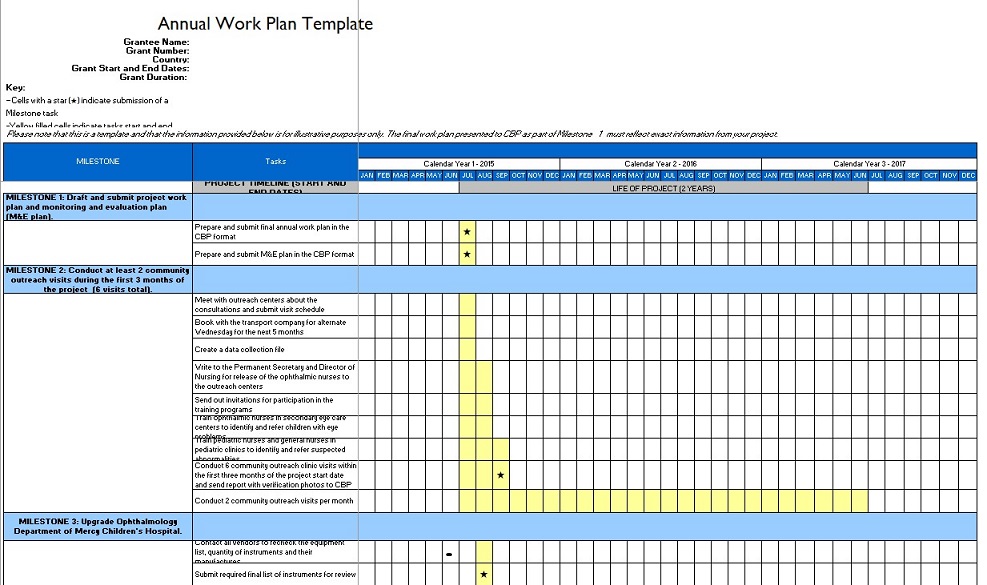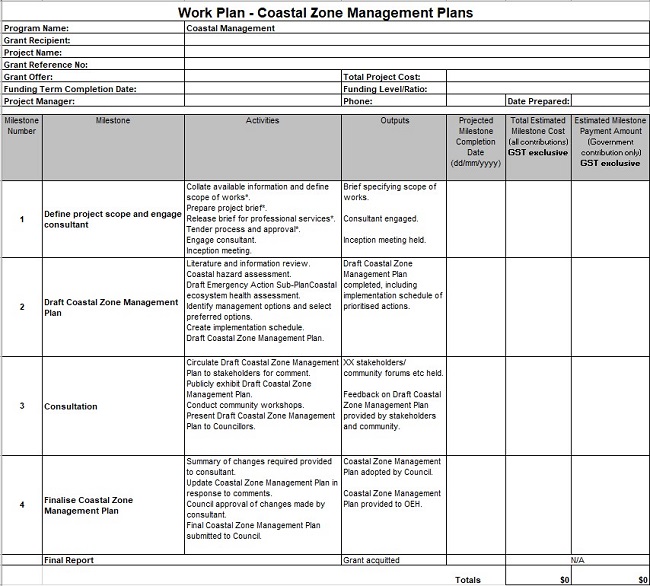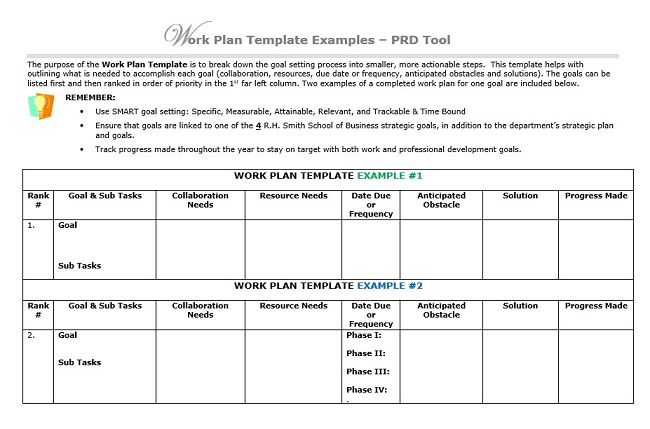Sample work plan templates are usually made for more organized and efficient projects. They should include all the tasks and activities in the project, who was assigned for each activity and task, and when those tasks should be done.
Usually, the work plan template will be made as part of the requirements when submitting the proposal for the project. After the project is agreed and started, this work plan will be used to track the ongoing project and check whether there is no delay
Purpose of Creating Work Plans
For Proposing Projects
Think of starting a project like starting a journey. Before you start, you need a map. That’s what a work plan is! It shows everyone what the project will look like and what steps will be taken. When people see this plan, they know you’ve thought everything through.
Checking on Projects
Once you start a project, you want to know how it’s going. The work plan is like a checklist. You can see which tasks are done and which ones are left. It helps make sure the project goes smoothly.
Stopping Delays
Nobody likes it when things get delayed. If a task takes too long, the work plan lets you spot it quickly. You can then figure out how to fix it and keep everything on track.
Making work plans helps start projects correctly, check how they go, and ensure they finish on time! It’s like having a helper for your project.
Why Should You Pick the Right Work Plan Template?
Picking the right work plan template is super important. Let’s see why:
Match Your Goals
Every project has different goals. The right template makes sure you focus on these goals.
Save Time and Effort
A good template helps you do things faster. You know what to do next, and don’t waste time.
Better Team Talk
When everyone uses the same plan, they understand better. It means less confusion and better teamwork.
Use Resources Well
With the right plan, you use your tools and people best. No wasting!
Keep Everyone Interested
Different people want to see different things. A good template shows them what they want to know.
Change When Needed
Sometimes, you need to change your plan. A good template lets you do that easily.
Avoid Problems
If you have a good plan, you can see problems before they happen. It means fewer surprises.
See How Well You’re Doing
A good template lets you see if you’re doing things right. If not, you can change and do better.
So, picking the right template is like having a good map. It helps you go in the right direction and reach your goals faster!
Components of a Work Plan Template
A work plan template offers a structured format to navigate and manage projects effectively.
By breaking the project into specific components, teams can ensure a smoother execution and better foresee challenges. Here’s a closer look at each component:
The Description of the Project
Every work plan starts with an overview of the project. It’s essential to provide a brief but clear summary of the project. For instance, if a company is looking to expand its digital footprint, the description might highlight the creation of a new e-commerce website. This foundational step ensures that all team members have a unified understanding of the project’s core.
The Most Important Issues
Any project comes with its set of challenges. Identifying these early on helps in being proactive rather than reactive. For example, the digital expansion could face issues like website security concerns or competition from established e-commerce entities. Addressing these upfront ensures the team is prepared for potential roadblocks.
The Objectives and Goals
The heart of the work plan lies in its objectives and goals. In the context of our e-commerce example, one objective might be “to attract 10,000 unique visitors in the first month.” Setting clear and measurable objectives keeps the project on a defined path.
The Key Strategies You Are to Employ
Behind every objective, there’s a strategy that charts the path to its achievement. It’s about answering the ‘how’ of the goals. If the goal is to attract many visitors, a strategy could involve partnering with influencers for promotions. These strategies are pivotal as they map the journey towards the set objectives.
The Budget and Resources
Every project runs with resources. This part of the template delves into the financial and logistical aspects. It breaks down the monetary budget, equipment, personnel, and other essential resources. For the e-commerce site, this might include website hosting costs, payment gateway fees, and marketing budgets.
The Schedule or Timeline
Time is of the essence in any project. The schedule component of the work plan lays out the timeline for each task and milestone. If we stick to our e-commerce example, there might be dates for website beta testing, the official launch, and the first marketing campaign. A clear timeline ensures the project stays on track and meets its deadlines.
Different Types of Work Plan Templates
Work plans help guide our tasks and keep things running smoothly. But not all work plans are the same. They differ based on who uses them and what they’re for. Let’s dive into the various types you might come across:
For Employees
- Who Is It For? People working in small businesses or teams.
- What’s In It? It’s all about tasks! This plan lists out tasks and who’s going to do them. It also sets out when they need to be done.
- Example: Think about a new product the company wants to introduce. There might be tasks like “Design the product” or “Test the product.” This plan makes sure everyone knows their job.
For Managers
- Who Is It For? Those leading bigger groups like departments or large teams.
- What’s In It? This one’s more detailed. Apart from tasks and dates, it talks about money and resources. How much will things cost? What things (like tools or people) are needed? It answers these questions.
- Example: Let’s say there’s a big sale event. This plan might include budgets for advertising, lists of items to be put on sale, and staff schedules.
For Business Owners
- Who Is It For? The people who run the whole show!
- What’s In It? It is the grand plan. It has everything the other plans have, plus big-picture stuff. It looks at the market, thinks about the future, and lays out the big dreams.
- Example: An owner might consider starting a new branch or introducing a groundbreaking new product. This plan lays out the whole journey, from idea to reality.
For Consultants
- Who Is It For? Experts who advise other businesses or people.
- What’s In It? This plan focuses on analysis and solutions. Consultants look at problems, discover why they’re happening, and suggest how to fix them. Their work plan also has timelines for when they’ll study things, give feedback, and when solutions should start.
- Example: Imagine a business is losing customers and doesn’t know why. A consultant’s plan might include chatting with customers, checking out the company’s products, and suggesting ways to improve things.
Free Sample Work Plan Templates
Printable Work Plan Template

Sometimes, having a physical paper before you can make tasks more manageable. The Printable Work Plan Template is perfect for those who prefer a tangible list. You can print it out, stick it on your desk or wall, and cross off tasks as you complete them. It’s a classic and effective way to stay on track.
Weekly Work Plan Template

For those who like to plan in chunks, the Weekly Work Plan Template is ideal. With spaces for tasks from Monday to Sunday, you can easily distribute your tasks throughout the week. It ensures you’re not cramming everything into one day and helps you balance your workload.
Daily Work Plan Template

Need to get super detailed? The Daily Work Plan Template lets you break down your day hour by hour or task by task. It ensures you’re allocating time effectively, making the most of your day.
Project Work Plan Template
Projects can get overwhelming without a solid plan. With the Project Work Plan Template, you can list tasks, assign team members, and set deadlines. This centralized document ensures everyone knows their responsibilities, promoting smoother project execution.
Annual Work Plan Template

Some goals are long-term. The Annual Work Plan Template lets you map your objectives for the entire year. Whether it’s a personal goal like fitness or professional targets, this template provides a bird’s eye view of your year.
Employee Work Plan Template
An Employee Work Plan Template assists employees in tracking their tasks and progress. It’s not just a list of tasks but also a tool to review achievements and areas of improvement, helping in career growth.
Internship Work Plan Template
Interns often start with a flurry of enthusiasm, but without direction, that can wane. This template gives structure to their role, listing down tasks, learning objectives, and goals for the internship duration. It provides clarity and ensures the internship is mutually beneficial.
A structured work plan template, whatever its use, ensures better productivity clarity in tasks and provides a roadmap to achieving goals. With these templates, you’re better prepared to tackle big and small tasks.
Monthly Work Plan Template

Want to see your month’s tasks? Use this Excel sheet. It looks like a calendar. Plus, it does math for you and uses colors to show what’s done.
Professional Work Plan Template

Got a big project or starting a business? This one’s for you. It lists what you want to achieve, how to check it, and when things should happen. It’s made to be clear and fancy.
Work Plan in PowerPoint (PPT)

Showing your plan in a meeting? Use the PowerPoint version. It turns tasks into slides. And you can use pictures like charts.
Work Plan in Word

Like writing? Use the Word version. It’s simple, and you can change it easily. You can write tasks, make notes, or use tables.
Work Plan in Excel

If you like lists, use the Excel version. It has boxes and lines. It also lets you count days or check how much you’ve done.
Event Work Plan Template

Planning an event? This one helps you remember everything. It lists guests, places, and what will happen. This way, you will remember everything.


These tools make planning fun and easy. Pick the right one, fill it in, and get started!
Common Mistakes When Using a Work Plan Template
However, mistakes can be made during the planning phase, even with the best templates.
Here is the most common mistake made when using work plan templates and offer insights on avoiding them.
- Lack of Clarity:
A frequent mistake is needing to be clearer and specific about tasks, goals, and objectives. Vague descriptions can lead to clarity, misinterpretation, and tasks needing to be completed as intended.
- Overloading the Plan:
Trying to include too much in a single work plan can be overwhelming. Instead of ensuring that everything gets done, it can lead to paralysis or tasks being done hastily and without due care.
- Not Allocating Resources Properly:
Failing to consider and allocate resources (like time, money, and workforce) effectively can result in project delays and overspending.
- Ignoring Potential Risks:
Every project has risks. Not identifying or preparing for these risks in the work plan can lead to unforeseen challenges and disruptions.
- Not Reviewing and Updating:
Setting and forgetting a common mistake. Work plans must be living documents regularly reviewed and updated to reflect changes and progress.
- Not Being Flexible:
While having a plan is essential, being flexible is equally crucial. Strictly adhering to a plan without accommodating necessary changes can hinder project success.
- Not Assigning Clear Responsibilities:
Every task needs a responsible person or team. With clear ownership, tasks can be addressed, assuming someone else will handle them.
- Neglecting Communication:
Even with a perfect work plan, failing to communicate its contents and updates to all stakeholders can result in misalignment and mistakes.
- Overcomplicating the Template:
While details are vital, an overly complicated template can be confusing. It’s essential to strike a balance to ensure the work plan is comprehensive yet user-friendly.
- Not Training Team Members:
Team members need to become more familiar with how to use or interpret the work plan template so that mistakes can occur. Providing the necessary training or orientation when introducing a new template is essential.
Conclusion
Sample work plan templates – In business and projects, you need clear steps. Using the right sample work plan templates helps a lot. It can make everything clearer and guide your way.
FAQs
What is a Work Plan Template?
A work plan template is a structured document used to outline the details of a specific project or task.
Why is a Work Plan Template essential for project management?
It provides a roadmap for the project, ensuring all tasks are organized and allocated correctly. It also aids in tracking progress, managing resources, and meeting deadlines, ultimately ensuring the project’s success.
Can I use a Work Plan Template for small-scale tasks?
While work plans are often associated with larger projects, they can benefit any task, big or small. They bring clarity, focus, and organization, regardless of the project’s size.
How often should the Work Plan be updated?
It depends on the project’s nature and duration. Reviewing and updating the work plan regularly, like weekly or monthly, for long-term projects is advisable. For shorter tasks, updates might occur as tasks are completed or as changes arise.
Are there different types of Work Plan Templates?
Yes, various templates are tailored for different roles, such as employees, managers, and business owners. The template’s structure might remain similar, but the depth and detail can vary depending on the target audience and the project’s scope.
Do I need special software to create a Work Plan Template?
While there are specialized software and tools for project management that offer work plan templates, you can also create a simple work plan using programs like Microsoft Word or Excel. The key is to ensure clarity and organization in the document.
How detailed should my Work Plan Template be?
The level of detail depends on the project and its complexity. However, keeping the template concise and easy to follow is also essential.
Can I reuse a Work Plan Template for other projects?
Yes, templates are designed to be adaptable.
How do I ensure everyone follows the Work Plan?
Regular check-ins and progress meetings help ensure everyone is on track. Using collaborative tools where team members can mark tasks as completed can also provide transparency and encourage accountability.
What should I do if there are deviations from the Work Plan?
It’s natural for unforeseen changes or challenges to arise during a project. If there are deviations, review the work plan, adjust the tasks or timelines if necessary, and communicate the changes to all team members to ensure everyone is aligned.

The content creator team at calipsotree.com is dedicated to making topics accessible to everyone, with over 9 years of experience in writing and breaking down complex concepts into easy-to-understand articles that answer readers’ financial questions.








